Euro coins catalog and price guide
Common side
2 and 1 euro, 50, 20 and 10 cents until 2007Map of Europe showing only the member countries of the European Union, six lines with stars at each end.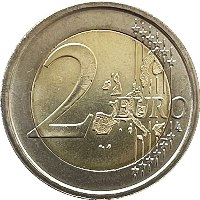
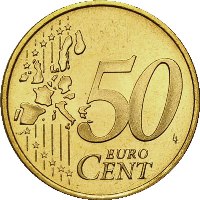
2 and 1 euro, 50, 20 and 10 cents after 2007
Complete map of Europe, six lines with stars at each end.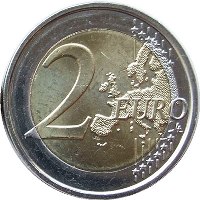
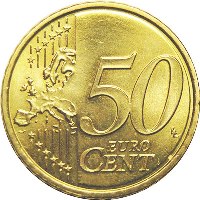
5, 2 and 1 eurocent
Globe, six lines with stars at each end.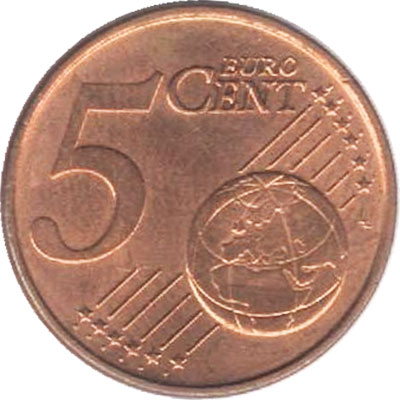
Year of the introduction of euro coins with a new type of reverse
Andorra 2014
Austria 2008
Belgium 2007
Cyprus 2008
Estonia 2011
Finland 2007
France 2007
Germany 2007
Greece 2007
Ireland 2007
Italy 2008
Latvia 2014
Luxembourg 2007
Malta 2008
Monaco 2007
Netherlands 2007
Portugal 2008
San Marino 2008
Slovakia 2009
Slovenia 2007
Spain 2007
Vatican 2008
Description of euro coins by denominations
| Face value | ø | Thickness | Weight | Alloy | Edge |
| 1 cent | 16.25 mm | 1.67 mm | 2.30 g | copper plated steel | smooth |
| 2 cents | 18.75 mm | 1.67 mm | 3.06 g | copper plated steel | smooth |
| 5 cents | 21.25 mm | 1.67 mm | 3.92 g | copper plated steel | smooth |
| 10 cents | 19.75 mm | 1.93 mm | 4.10 g | "Northern gold" (Cu89 Al5 Zn5 Sn1) | coarsely corrugated |
| 20 cents | 22.25 mm | 2.14 mm | 5.74 g | "Northern gold" (Cu89 Al5 Zn5 Sn1) | smooth with seven indentations ("Spanish flower" shape) |
| 50 cents | 24.25 mm | 2.38 mm | 7.80 g | "Northern gold" (Cu89 Al5 Zn5 Sn1) | coarsely corrugated |
| 1 euro | 23.25 mm | 2.33 mm | 7.50 g | Outer ring Nickel brass (Cu75 Zn20 Ni5), the inner part is three-layer: Cu-Ni; Ni; Cu-Ni | corrugated with three smooth sections |
| 2 euro | 25.75 mm | 2.20 mm | 8.50 g | Outer ring: Cu-Ni, The inner part is three-layer: Cu75 Zn20 Ni5; Ni; Cu75 Zn20 Ni5 | corrugated with lettering |
Inscriptions on edges of 2-euro coins from different countries
Austria
Andorra

Belgium

Vatican

Germany
 In German "UNITY AND RIGHT AND FREEDOM" from "Song of the Germans"
In German "UNITY AND RIGHT AND FREEDOM" from "Song of the Germans"Greece
 In Greek "GREEK REPUBLIC"
In Greek "GREEK REPUBLIC"Ireland

Spain

Italy

Cyprus

Latvia
 in Latvian "GOD BLESS LATVIA" - the name of the national anthem of Latvia
in Latvian "GOD BLESS LATVIA" - the name of the national anthem of LatviaLithuania
 FREEDOM * UNITY * WELFARE * in Lithuanian
FREEDOM * UNITY * WELFARE * in LithuanianLuxembourg

Malta
 Image of Maltese crosses between inversely located numbers 2
Image of Maltese crosses between inversely located numbers 2Monaco

Netherlands
 In Dutch "GOD WITH US"
In Dutch "GOD WITH US"Portugal
 7 stylized castles and 5 coats of arms
7 stylized castles and 5 coats of armsSan Marino

Slovakia
 In Slovak "SLOVAK REPUBLIC"
In Slovak "SLOVAK REPUBLIC"Slovenia
S L O V E N I J A •
In Slovenian "SLOVENIA"
Finland
 "FINLAND" in Finnish and Swedish, as well as three stylized lion heads
"FINLAND" in Finnish and Swedish, as well as three stylized lion headsFrance

Estonia
.svg.png) "ESTONIA" in Estonian, direct and inverse, separated by a circle
"ESTONIA" in Estonian, direct and inverse, separated by a circleEuro coins by the countries
AndorraAustria
Austrian commemorative euro
Belgium
Belgian commemorative euro
Croatia
Cyprus
Estonia
Finland
France
French commemorative euro
Germany
German commemorative euro
Greece
Italy
Italian commemorative euro
Ireland
Latvia
Lithuania
Luxembourg
Malta
Maltese commemorative euro
Monaco
Netherlands
Portugal
San Marino
Slovakia
Slovenia
Spain
Spanish commemorative euro
Vatican
Brief catalog-identifier of euro coins
Circulation euro coins by the face values
2 euro1 euro
50 euro cent
20 euro cent
10 euro cent
5 euro cent
2 euro cent
1 euro cent
Commemorative 2 euro
Series
Treaty of Rome - 50th anniversaryEconomic and Monetary Union (EMU) - 10th anniversary
Euro coins and banknotes - 10th anniversary
EU flag - 30th anniversary
35 years of the Erasmus Programme
Commemorative 2 euro by the years
20042005
2006
2007
2008
2009
2010
2011
2012
2013
2014
2015
2016
2017
2018
2019
2020
2021
2022
2023
2024
2025

